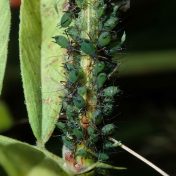Late damage has been reported recently in an Onyx-AU (PBR*) black gram crop in the Burdekin. The most obvious damage was dead leaves, but closer inspection found full sized larvae (3 mm) and pupae in the petioles of damaged leaves. The causal agent was common bean fly Ophiomyia phaseoli (Agromyzidae), but in this instance control was not warranted, as the… Read more »
Halo blight, caused by a bacterial pathogen (Pseudomonas savastanoi pv. phaseolicola) is one of the major diseases of beans world-wide, particularly in temperate regions. In mungbean, symptoms on leaves start as small, water-soaked lesions that are surrounded by a yellow-green halo (Figs 1 and 2). Symptoms may be visible at the 1st or 2nd trifoliate leaf stage and are often… Read more »
Since early 2020, growers and agronomists have been nervous about the prospect of fall armyworm (FAW; Spodoptera frugiperda) invading their crops. So far, the majority of significant and damaging FAW infestations have been recorded from sweet corn, maize, and sorghum crops, with some isolated outbreaks in horticultural crops such as ginger and capsicum. Occurrences in other crops have been a… Read more »
After an initial report in Sydney, faba bean aphid (FBA – Megoura crassicauda) was confirmed in September 2017 in faba beans in Tamworth and Breeza. Very few commercial faba bean crops were sown during the drought in 2018 and 2019, however seasonal conditions then improved and FBA was found in July 2020 in faba bean trials in Grafton. This infestation… Read more »
It was expected that many southern Queensland regions would be too cold for fall armyworm (FAW) (Spodoptera frugiperda) to survive. However larval populations were found in the South Burnett and Lockyer Valleys, and small numbers of moths were also detected in pheromone traps on the Darling Downs this winter. Caterpillars and moths in the South Burnett In July, larvae were… Read more »
From this winter, the Beatsheet will start expanding to incorporate information on broadacre crop diseases (including alerts, identification and management). Recent alerts have been issued to watch for the diseases below: Ascochyta blight – reported in chickpeas in the eastern Downs Cereal rust – reported from southern Queensland and northern New South Wales. Bean yellow mosaic virus – detected in… Read more »
As we enter the business end of the season, we want our soybean crop’s leaves to be a healthy green, as the healthier the leaves, the more the pods fill and the higher the yield. In a drought year, dryland crops turn brown prematurely due to lack of water, but in wet years or in irrigated crops, leaves should not… Read more »
Fall armyworm (FAW) are still active across the Northern Grains Region, but inland Central and Southern Queensland have not experienced continuous population build up in crops since the first immigration of moths in September–October. One of the major contributors to this continuing low pressure is probably the very high natural enemy (beneficial) impact on FAW. A number of very common… Read more »
Most people check the outlook for storms, but have you checked the outlook for swarms recently? After the widespread plague locust activity in southern Queensland and northern NSW in late spring to early summer in 2020, and given the recent rain in some districts, you might be interested to know what the outlook is for locusts and grasshoppers in your… Read more »
Another exotic leaf-mining fly, the serpentine leafminer (SLM; Liriomyza huidobrensis), also known as pea leafminer or South American leafminer, has recently been found in commercial vegetable crops (celery and green beans) in the Fassifern Valley (90 km south-west of Brisbane). This follows its previous detection in western Sydney in early November. The national plant pest and disease incursions technical committee… Read more »










